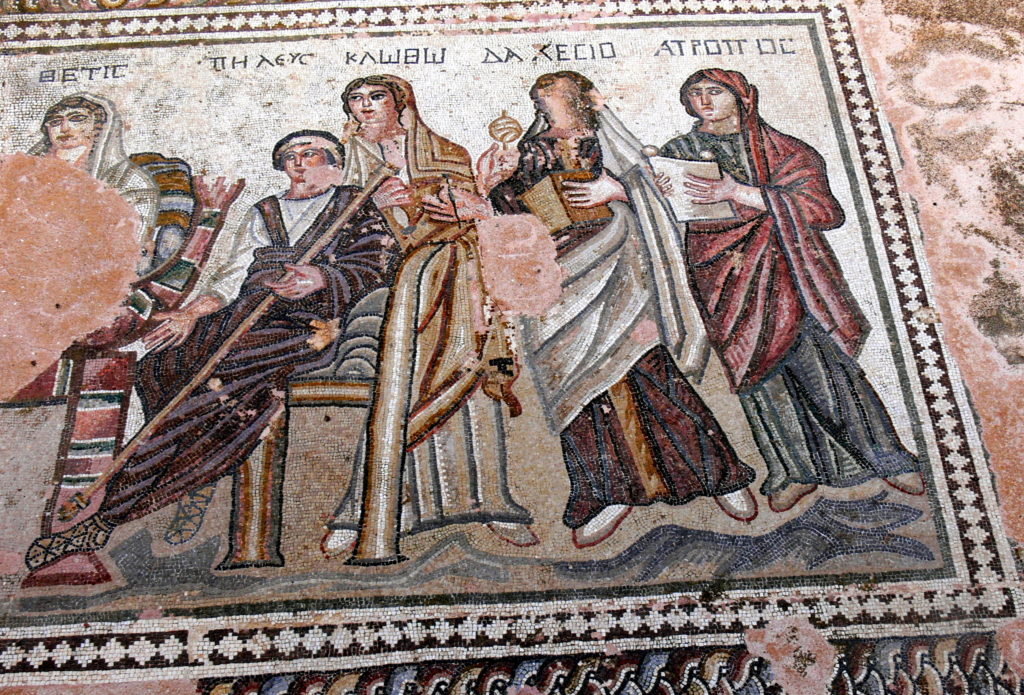Last updated on January 25th, 2023 at 10:38 pm
In Ancient Greece, religious life, mythology, and literature were almost indistinguishable. Some of the earliest Greek writers, such as Homer, the quasi-fabled author of the Illiad and the Odyssey, and Hesiod, a Greek poet of the eighth century BC who composed the Theogony and Works and Days, discuss the Greek gods like Zeus, Athena and Poseidon side by side with heroes such as Achilles and demi-gods and mythological characters such as Heracles and the monstrous one-eyed Cyclops.
Later prominent Greek playwrights of the fifth and fourth centuries BC, such as Aeschylus, Sophocles, and Euripides, featured many Greek religious and mythological characters in their many plays.
Thus Greek religion and mythology were tangible things in the ancient Greek world. The Three Fates or the Moirai are Greek mythology elements that appear regularly in many aspects of Hellenistic culture.

Who were the Three Fates?
Originally, the Fates or Moirai were described as one entity, which is how Homer depicted them. However, by Hesiod’s time of writing several hundred years later, they had come to be understood as three individual characters known as the Three Fates.
These were Atropos, Lachesis, and Clotho and were described as fatherless beings spawned by Nyx, the female incarnation of the Night.
Collectively the trio was responsible for the threads of life.
Clotho, known as ‘The Spinner,’ spun the thread of life. In contrast, Lachesis, often known as ‘The Allotter,’ then determined how long it would be for each mortal being before Atropos, who is typically identified as the eldest of the Three Fates and termed ‘The Inflexible One,’ determined when the thread of a mortal being’s life would be severed.
Thus, the Three Fates had significant powers of control over the lives of humans, deciding much about how long a person would live and what shape their earthly lives would take.
Because of her role in bringing about the end of the lives of mortal beings, Atropos is generally featured most prominently in stories from Greek mythology.
Despite these powers, the Three Fates were not deities, but personifications of life aspects, much like the Muses who personified aspects of creativity and culture.
The Three Fates in Greek Mythology
As a result of their significant role in the matrix of Greek mythology, the Three Fates were central to many prominent tales in Ancient Greece. For instance, in the Odyssey, the Moirai work with the goddess Athena to shape Odysseus’s fate in his ten-year journey home from Troy to Ithaca following the legendary Trojan War.
In other instances, they appeared to be acting on their own in some mythological tale. One such example concerned Clotho, who assisted Hermes, the messenger of the gods, in creating an alphabet for humans.
A tale from Greek mythology in which the trio was particularly prominent was that of Meleager and the hunt for the Calydonian Boar.
This is stated to have occurred before the Trojan War and involved Meleager hunting down and killing the Calydonian Boar, which Artemis, the Greek goddess of the hunt, had sent to terrorize Aetolia north of the Gulf of Corinth.
Meleager dies at the end of the mythical tale, a destiny that the Three Fates had foretold in most renderings of the story of the Hunt for the Calydonian Boar.
This prominence within Greek mythology and religious life translated into many shrines and cults dedicated to the Three Fates throughout the Greek world during the Classical period of Greek history between the sixth and fourth centuries.
Their three most important temples were at Corinth, Sparta, and Thebes, three of the most significant city-states in the Greek world.
The Three Fates Outside Greek Mythology
The Three Fates were not restricted to Ancient Greece. As with so much else of the ancient culture of the Mediterranean world, Greek mythology was absorbed into Roman culture, where the Parcae was a near-carbon copy of the Moirai.
Here Clotho became Nona, Lachesis became Decima and Atropos became Morta. The Three Fates carried greater reverence in the Roman system, largely subject only to Jupiter, the Roman equivalent of Zeus and thus the King of the Gods.
As a result of this prominence of the Parcae within both Hellenistic and Roman culture and mythology, the Three Fates featured prominently in the cultural and artistic explosion of the Renaissance in Italy.
For instance, the acclaimed mid-sixteenth-century painter Marco Bigio’s most celebrated work is The Three Parcae which resides in the Villa Barberini in Rome today.
Earlier, they featured as characters in Dante’s Divine Comedy, one of the most significant literary works of the Italian Renaissance. Later, when the Renaissance spread to northern Europe, the Fates featured in such renowned works as Peter Paul Rubens’s The Three Parcae Spinning the Fate of Marie de Medici.
Finally, this influence continued into the Baroque and Romantic art of the seventeenth, eighteenth, and nineteenth centuries, notably The Night of Enitharmon’s Joy, painted by the British artistic polymath William Blake. This featured the Moirai and was produced in 1795.
One of Blake’s most accomplished works, the painting hangs today in the Tate Gallery in London. Thus, the Three Fates have remained a constant feature of the cultural legacy of the ancient world down to the present day.
Sources
William Smith, Dictionary of Greek and Roman Biography and Mythology, Volume 2 (Cambridge, 1870), pp. 1109–1110.
B. C. Dietrich, ‘The Spinning of Fate in Homer’, in Phoenix, Vol. 16, No. 2 (Summer, 1962), pp. 86–101; James Duffy, ‘Homer’s Conception of Fate’, in The Classical Journal, Vol. 42, No. 8 (May, 1947), pp. 477–485; Judith M. Barringer, ‘Atalanta as Model: The Hunter and the Hunted’, in Classical Antiquity, Vol. 15, No. 1 (April, 1996), pp. 48–76.
Svetlana L. Alpers, ‘Manner and Meaning in Some Rubens Mythologies’, in Journal of the Warburg and Courtauld Institutes, Vol. 30 (1967), pp. 272–295; John Sutherland, ‘Blake: A Crisis of Love and Jealousy’, in Proceedings of the Modern Language Association, Vol. 87, No. 3 (May, 1972), pp. 424–431.

